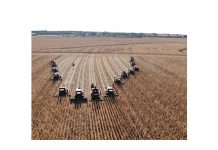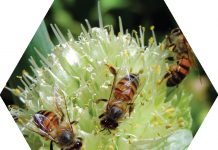There is a common misunderstanding about the directions for use of pesticides. Although they are often interpreted to be recommendations, they are instructions. This means that users must adhere to whatever is stated on the label.
All pesticide labels must conform to a particular format. A label consists of four main sections, namely the main panel or sales panel, warnings, precautions and directions for use. No one section is more important than the other, hence the user of the pesticide must fully read and understand all the sections.
Main or sales panel
This part of the label displays all the regulatory and technical details of the pesticide. It must include the following information:
- The trade name at the top of the main panel, printed in bold. Every product has a trade name. It sometimes reflects the active ingredient (such as Glyphosate 360SL) or it can simply be a name with no reference to the active ingredient (such as WeedForce 480SC).
- A registration number, which is a capital L followed by four digits and Act No. 36 of 1947. L refers to landbou as in landboumiddel, the Afrikaans name for an agricultural remedy. Every pesticide has a unique number, but it is possible for a registration holder to split a pesticide into a few different brands based on the targets. Such pesticides will then all have the same registration number with very similar trade names.
- The general purpose or description of the pesticide is just below the registration details, such as ‘A suspension concentrate insecticide for the control of thrips in citrus and various other crops as described’.
- A resistance group code is given as a guide to managing the resistance of the pests, pathogens or weeds against the active ingredient(s) in the formulation.
- Thereafter the contents are displayed, meaning the active ingredients, their chemical or biological category and their concentrations in the formulation.
- The name, address and telephone number of the registration holder must be displayed prominently. This is often accompanied by the details of the marketing partner. The trademark (insignia of the registration holder or marketing partner) is also printed close to the registration holder’s details.
- Emergency telephone numbers and technical advice numbers are usually placed below the registration holder details.
- The UN number of the product is just above the colour band. This number is a classification code required for the marine and land shipment (transport) of hazardous substances and is used by transporters (conveyors) to determine load quantities and combinations.
- Pack size (quantity in terms of mass or volume) is printed close to the bottom of the main panel.
- The hazard classification according to the World Health Organisation’s criteria (colour band and hazard symbol, if any) and safety pictograms are at the bottom of the label.
- Pictograms are included in the colour band.
- Other information may also be displayed on the main panel, for example organic certification.
- Artwork is not a necessity, but is often included as part of the main panel to draw the user’s attention to the crops or the pest that may be controlled by the pesticide.
- The date of manufacture (or expiry date if required) and batch number must also be displayed.
Side panels
The side panels are divided into two sections – one that contains the compulsory warnings and precautions and the other that offers all the directions for use.
Warnings
All labels carry safety warnings that must be adhered to. These include:
- Safe storage behind lock and key and keeping pesticides out of reach of children and animals.
- Toxicity for mammals, birds, bees and aquatic organisms.
- Possible health effects like eye irritation, dermal irritation and very toxic if swallowed.
- Disclaimer about the product’s efficacy and compatibility with crops. This disclaimer is required because the registration holder has no control over the end-point application. If the pesticide is not applied strictly according to the label instructions, the registration holder is exempted from any claims that may arise from poor performance, harmful effects or crop damage.
- Withholding periods (preharvest intervals). One of the critical parts of warnings for crop producers is the subsection of withholding periods or preharvest intervals. It lists every crop for which the product is registered and the withholding period for such crops.
- Re-entry period. The label will offer guidance on when it is safe for people to enter the treated area and what safety precautions need to be implemented as such.
Precautions
Precautions include many different themes, namely:
- Personal protective clothing and equipment that may be required when working with or applying the pesticide.
- Notes on personal protection such as avoiding inhaling spray mist or dermal contact.
- Personal sanitation after use, like washing the hands and face or showering.
- Prevention of crop damage or environmental pollution by spray drift.
- Advice in the event of exposure that includes guidance to medical specialists for treatment of patients that were exposed to the pesticide.
- Disposal of empty containers that includes guidance on triple rinsing, puncturing, recycling and refraining from burning or burying empty containers.
- Special mixing instructions that guide the user on how to prepare the spray mixture. This is often required for pesticides that must be mixed with other pesticides, such as mancozeb with a strobilurin for citrus black spot or a special adjuvant that is required for the optimal functioning of the pesticide. It may also provide guidance on the pH of the water that is used for mixing.
- Resistance management is a very important piece of information that is too often ignored. It provides guidance on the maximum number of applications per season, spray intervals and switching to other modes of action to prevent resistance progression.
- Aerial application instructions that may only be on the label if the pesticide is registered for aerial application. These instructions are not only for the producer, but also for the aerial applicator (pilot). It gives parameters under which the aerial application must be done as well as guidance on droplet size, maximum wind speed and avoiding temperature inversions.
- Prohibition notices are applicable to certain pesticides that may not be applied in certain areas. For example, 2,4-D esters may not be applied in certain provinces.
Directions for use or application instructions
Regulation No. R1716 of 26 July 1991 stipulates that label instructions must be adhered to. A pesticide may only be used for the purpose and in the manner instructed (not recommended) by the label. Directions for use may have special instructions for some crops, followed by the table that lists the targets (plant pests, diseases or weeds), the dosage and associated mixing and application instructions.
Dosage is a challenge for some people because the instructions for pesticides used at farm level are mostly a quantity per hectare instead of a quantity per volume of spray water. In some cases, the directions for use will instruct the user to use a minimum volume of spray water per hectare; this will obviously be used in calculating the quantity of pesticide that goes into the spray tank.
Compatibility
Most pesticide labels have concluding statements about the compatibility of the pesticide with other pesticides. The registration holder cannot guarantee that the pesticide will function as expected if it is mixed with other pesticides.
Conclusion
The pesticide label is the only legal document of the product. No other information offered verbally, electronically or in writing overrides the label. Adhere to label instructions in order to get the best out of any pesticide.


















